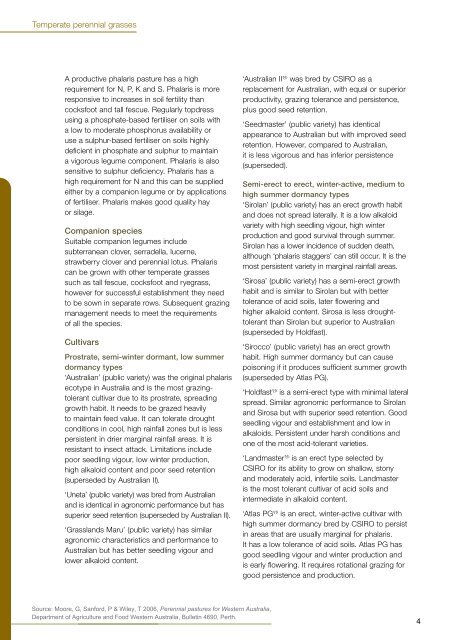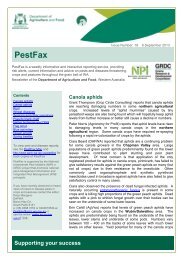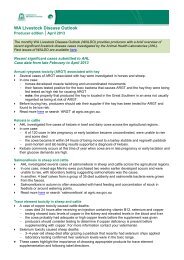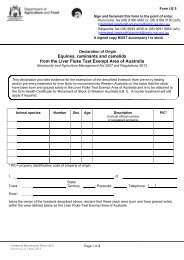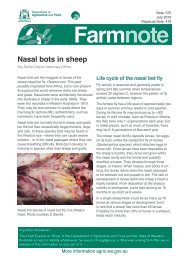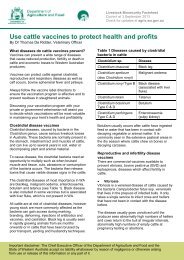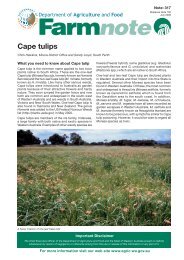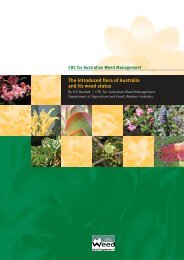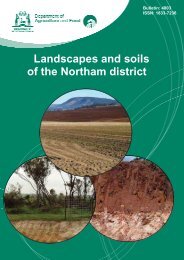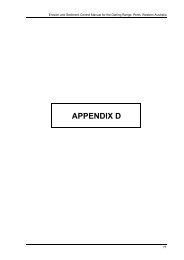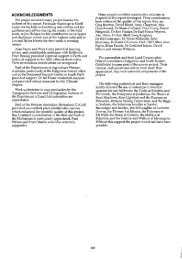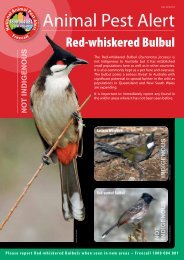Phalaris (Phalaris aquatica) - Department of Agriculture and Food
Phalaris (Phalaris aquatica) - Department of Agriculture and Food
Phalaris (Phalaris aquatica) - Department of Agriculture and Food
Create successful ePaper yourself
Turn your PDF publications into a flip-book with our unique Google optimized e-Paper software.
Temperate perennial grasses<br />
A productive phalaris pasture has a high<br />
requirement for N, P, K <strong>and</strong> S. <strong>Phalaris</strong> is more<br />
responsive to increases in soil fertility than<br />
cocksfoot <strong>and</strong> tall fescue. Regularly topdress<br />
using a phosphate-based fertiliser on soils with<br />
a low to moderate phosphorus availability or<br />
use a sulphur-based fertiliser on soils highly<br />
deficient in phosphate <strong>and</strong> sulphur to maintain<br />
a vigorous legume component. <strong>Phalaris</strong> is also<br />
sensitive to sulphur deficiency. <strong>Phalaris</strong> has a<br />
high requirement for N <strong>and</strong> this can be supplied<br />
either by a companion legume or by applications<br />
<strong>of</strong> fertiliser. <strong>Phalaris</strong> makes good quality hay<br />
or silage.<br />
Companion species<br />
Suitable companion legumes include<br />
subterranean clover, serradella, lucerne,<br />
strawberry clover <strong>and</strong> perennial lotus. <strong>Phalaris</strong><br />
can be grown with other temperate grasses<br />
such as tall fescue, cocksfoot <strong>and</strong> ryegrass,<br />
however for successful establishment they need<br />
to be sown in separate rows. Subsequent grazing<br />
management needs to meet the requirements<br />
<strong>of</strong> all the species.<br />
Cultivars<br />
Prostrate, semi-winter dormant, low summer<br />
dormancy types<br />
‘Australian’ (public variety) was the original phalaris<br />
ecotype in Australia <strong>and</strong> is the most grazingtolerant<br />
cultivar due to its prostrate, spreading<br />
growth habit. It needs to be grazed heavily<br />
to maintain feed value. It can tolerate drought<br />
conditions in cool, high rainfall zones but is less<br />
persistent in drier marginal rainfall areas. It is<br />
resistant to insect attack. Limitations include<br />
poor seedling vigour, low winter production,<br />
high alkaloid content <strong>and</strong> poor seed retention<br />
(superseded by Australian II).<br />
‘Uneta’ (public variety) was bred from Australian<br />
<strong>and</strong> is identical in agronomic performance but has<br />
superior seed retention (superseded by Australian II).<br />
‘Grassl<strong>and</strong>s Maru’ (public variety) has similar<br />
agronomic characteristics <strong>and</strong> performance to<br />
Australian but has better seedling vigour <strong>and</strong><br />
lower alkaloid content.<br />
Source: Moore, G, Sanford, P & Wiley, T 2006, Perennial pastures for Western Australia,<br />
<strong>Department</strong> <strong>of</strong> <strong>Agriculture</strong> <strong>and</strong> <strong>Food</strong> Western Australia, Bulletin 4690, Perth.<br />
‘Australian II’ A was bred by CSIRO as a<br />
replacement for Australian, with equal or superior<br />
productivity, grazing tolerance <strong>and</strong> persistence,<br />
plus good seed retention.<br />
‘Seedmaster’ (public variety) has identical<br />
appearance to Australian but with improved seed<br />
retention. However, compared to Australian,<br />
it is less vigorous <strong>and</strong> has inferior persistence<br />
(superseded).<br />
Semi-erect to erect, winter-active, medium to<br />
high summer dormancy types<br />
‘Sirolan’ (public variety) has an erect growth habit<br />
<strong>and</strong> does not spread laterally. It is a low alkaloid<br />
variety with high seedling vigour, high winter<br />
production <strong>and</strong> good survival through summer.<br />
Sirolan has a lower incidence <strong>of</strong> sudden death,<br />
although ‘phalaris staggers’ can still occur. It is the<br />
most persistent variety in marginal rainfall areas.<br />
‘Sirosa’ (public variety) has a semi-erect growth<br />
habit <strong>and</strong> is similar to Sirolan but with better<br />
tolerance <strong>of</strong> acid soils, later flowering <strong>and</strong><br />
higher alkaloid content. Sirosa is less droughttolerant<br />
than Sirolan but superior to Australian<br />
(superseded by Holdfast).<br />
‘Sirocco’ (public variety) has an erect growth<br />
habit. High summer dormancy but can cause<br />
poisoning if it produces sufficient summer growth<br />
(superseded by Atlas PG).<br />
‘Holdfast’ A is a semi-erect type with minimal lateral<br />
spread. Similar agronomic performance to Sirolan<br />
<strong>and</strong> Sirosa but with superior seed retention. Good<br />
seedling vigour <strong>and</strong> establishment <strong>and</strong> low in<br />
alkaloids. Persistent under harsh conditions <strong>and</strong><br />
one <strong>of</strong> the most acid-tolerant varieties.<br />
‘L<strong>and</strong>master’ A is an erect type selected by<br />
CSIRO for its ability to grow on shallow, stony<br />
<strong>and</strong> moderately acid, infertile soils. L<strong>and</strong>master<br />
is the most tolerant cultivar <strong>of</strong> acid soils <strong>and</strong><br />
intermediate in alkaloid content.<br />
‘Atlas PG’ A is an erect, winter-active cultivar with<br />
high summer dormancy bred by CSIRO to persist<br />
in areas that are usually marginal for phalaris.<br />
It has a low tolerance <strong>of</strong> acid soils. Atlas PG has<br />
good seedling vigour <strong>and</strong> winter production <strong>and</strong><br />
is early flowering. It requires rotational grazing for<br />
good persistence <strong>and</strong> production.<br />
4


